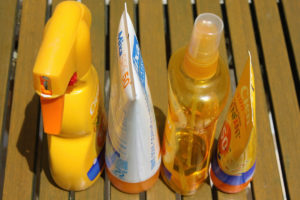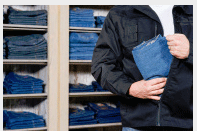 March is known for coming in like a lion and going out like a lamb. April showers bring May flowers but what in the world does May bring? May ushers in the summer sales season! Spring is wrapping up and now is the time to be getting your store ready for all of the shoppers looking for the items that will make the long, warm days of June, July and August a memorable time. The big stores are rolling out grills, picnic wares and yard games. They are loading up with tons of bathing suits, beach towels, sunscreens and sunglasses. The big boys appeal to all of the summer trends in almost every department. They are also preparing for criminal activity and preparing to prevent it.
March is known for coming in like a lion and going out like a lamb. April showers bring May flowers but what in the world does May bring? May ushers in the summer sales season! Spring is wrapping up and now is the time to be getting your store ready for all of the shoppers looking for the items that will make the long, warm days of June, July and August a memorable time. The big stores are rolling out grills, picnic wares and yard games. They are loading up with tons of bathing suits, beach towels, sunscreens and sunglasses. The big boys appeal to all of the summer trends in almost every department. They are also preparing for criminal activity and preparing to prevent it.
With the end of May families start to travel and take vacations, children and teens are out of school and so there is just more free time on people’s hands. No, I’m not advocating doing away with summer vacations from school (I remember my school days and my break times could never get here fast enough). The simple fact is that with more people coming and going into stores theft will increase as will sales. Big box retailers prepare for this influx of traffic. Store Managers are setting planograms and endcaps to encourage the sale of those items that are relevant to the tourist, vacationer and outdoor-minded families. Loss Prevention Managers are evaluating product placement and the appropriate retail anti-theft devices for the particular merchandise in question. They may also be reviewing camera coverage to ensure thieves will be discouraged from trying to steal. Electronic Article Surveillance Systems will be tested for functionality and that tagging standards are met. The small business retail owner could have to do such things on his/her own. If you are that owner you may not even think you have a store that lends itself to seasonal merchandise sales. Take a look again, you may have more items that can be season specific than you think. You may also be able to take advantage of Loss prevention measures you have not implemented yet.
If a store specializes in jewelry sales it may not occur to an owner that there is a seasonal element to it. Jewelry would seem to be a year-round item to sell but think about your merchandise in terms of accessorizing summer dresses or casual watches for a man preparing to go on a trip. Someone on a cruise may need jewelry that will accentuate an evening dress for formal dinners. How about the small corner grocer? What kind of impact can summer have in that store? Think about the traditional things we do during the summer days. We load up coolers with soft drinks and beer. We have cookouts with hot dogs, burgers, marshmallows, buns, condiments etcetera. Put the dry goods at the front of the store in high traffic areas to impact customer interest. Running a hardware store means putting lawn and garden care tools and supplies in front of the customers. Maybe you carry drink coolers or gas containers for boaters. Product placement is key to reminding customers what they need for the season.
As you begin strategizing about how the merchandise you carry can have a seasonal component you also want to think about whether those goods will be stolen. Retail merchandise anti-theft devices are available for nearly every single item that is sold. It is simply a matter of finding the correct tag or label for the item. If you are going to promote meat for summer cookouts you have to know that there are going to be shoplifters who will try to steal some of it. Using food-safe Checkpoint EAS labels will prevent pilferage while allowing you the freedom to fill your meat freezers with the items that will increase sales. Having a grill display may be an opportunity to use an Alpha Security cable lock to keep it from being rolled out the door. Condiments on that display can be protected with EAS soft tags. An end cap with bathing suits near the front of the store will drive sales and theft but clothing security tags will deter shoplifters. Jewelry store owners, you will be happy to know there are jewelry locks available to permit open-air display which can increase sales.
Be ready for summer. Sales will sizzle as the days heat up if you use May to get your merchandise in front of the shoppers. Prepare displays that will mesmerize your customers and entice them to make purchases. In the process, don’t forget to use merchandise protection strategies. Increased foot traffic does not have to mean increased theft if you protect your products with the appropriate devices.
 The scary shoplifting cases we hear and see on TV, or on newspapers in the United States, are becoming too commonplace to rendered us shocked.
The scary shoplifting cases we hear and see on TV, or on newspapers in the United States, are becoming too commonplace to rendered us shocked.  Recently, I conducted an employee theft investigation for a client. I want to share some of the findings from that investigation in the hopes that you can use it to review your own potential for losses.
Recently, I conducted an employee theft investigation for a client. I want to share some of the findings from that investigation in the hopes that you can use it to review your own potential for losses.  Sometime this year you will most likely be conducting an inventory. Some stores even conduct multiple inventories when they have high stock shortage results. While it does not necessarily translate to poor results, a lack of adequate preparation can have an impact on the final shortage numbers.
Sometime this year you will most likely be conducting an inventory. Some stores even conduct multiple inventories when they have high stock shortage results. While it does not necessarily translate to poor results, a lack of adequate preparation can have an impact on the final shortage numbers. Accidents can be costly to businesses. In fact, according to the
Accidents can be costly to businesses. In fact, according to the You know the drill. At the end of the day, you find your merchandise tags on the floor or hidden in your fitting rooms. Shoplifters bring your merchandise into a fitting room and put it on under their clothes. Sometimes many layers of your apparel are under the clothes they wore in.
You know the drill. At the end of the day, you find your merchandise tags on the floor or hidden in your fitting rooms. Shoplifters bring your merchandise into a fitting room and put it on under their clothes. Sometimes many layers of your apparel are under the clothes they wore in. I wonder if Santa Clause conducts background checks on his newly hired elves? I’ve been contemplating the chaos that would take place in Santa’s workshop if he just hired any old elf to work for him. Does Santa ever get into a time crunch right around June and bring in seasonal hires to help meet timelines to get all of the toys made? Imagine the pilferage that would ensue if Santa’s Helpers haven’t been properly screened for criminal activity before being brought on board. Defective dolls might be delivered to darling little girls who deserve better. No firetrucks for a little fella because a fiendish elf stole it.
I wonder if Santa Clause conducts background checks on his newly hired elves? I’ve been contemplating the chaos that would take place in Santa’s workshop if he just hired any old elf to work for him. Does Santa ever get into a time crunch right around June and bring in seasonal hires to help meet timelines to get all of the toys made? Imagine the pilferage that would ensue if Santa’s Helpers haven’t been properly screened for criminal activity before being brought on board. Defective dolls might be delivered to darling little girls who deserve better. No firetrucks for a little fella because a fiendish elf stole it. A Department of Corrections officer was arrested this week at a Walmart for shoplifting. The perpetrator was a former Walmart employee who had left to become a corrections officer. The incident was reported to the authorities, indicating the amount stolen was around $400 dollars during 45 visits at that particular Walmart.
A Department of Corrections officer was arrested this week at a Walmart for shoplifting. The perpetrator was a former Walmart employee who had left to become a corrections officer. The incident was reported to the authorities, indicating the amount stolen was around $400 dollars during 45 visits at that particular Walmart.
 We’ve all been there, we are on our way to work and the next thing you know you come to a standstill. Cars backed up as far as you can see and no one is going anywhere. The clock is ticking away and you begin to worry knowing you are going to be late getting to the office. You look for a side street to try to get out of the mess then, someone with a little bit of guts and a four-wheel drive truck pulls onto the shoulder of the road and speeds by everyone to get to their destination. Everyone gets to where they are going but some people are determined not to let obstacles get in their way and they take the fast track to get there. They went the same route they just overcame the obstacles that would get in their way.
We’ve all been there, we are on our way to work and the next thing you know you come to a standstill. Cars backed up as far as you can see and no one is going anywhere. The clock is ticking away and you begin to worry knowing you are going to be late getting to the office. You look for a side street to try to get out of the mess then, someone with a little bit of guts and a four-wheel drive truck pulls onto the shoulder of the road and speeds by everyone to get to their destination. Everyone gets to where they are going but some people are determined not to let obstacles get in their way and they take the fast track to get there. They went the same route they just overcame the obstacles that would get in their way.